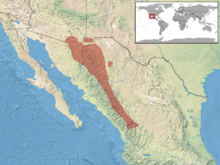Crotalus willardi
| Crotalus willardi | |
|---|---|
 |
|
| Scientific classification | |
| Kingdom: | Animalia |
| Phylum: | Chordata |
| Class: | Reptilia |
| Order: | Squamata |
| Suborder: | Serpentes |
| Family: | Viperidae |
| Genus: | Crotalus |
| Species: | C. willardi |
| Binomial name | |
|
Crotalus willardi Meek, 1905 |
|
 |
|
| Synonyms | |
Crotalus willardi is a venomous pit viper species found in the southwestern United States and Mexico.
The specific name, willardi, is in honor of its discoverer, "Professor" Frank Cottle Willard, a businessman from Tombstone, Arizona.
Originally described in 1905, Crotalus willardi is the most recent rattlesnake species to be discovered in the United States. Five subspecies are currently recognized, including the nominate subspecies, Crotalus willardi willardi, described here.C. w. willardi is commonly known as the Arizona ridge-nosed rattlesnake, and is the state reptile of Arizona.
Crotalus willardi is a rather small rattlesnake with all subspecies measuring one to two feet (30–60 cm) in length. Color patterns are generally a dark brown base with pale or white horizontal striping, but vary slightly among subspecies. The distinctive ridges along each side of its nose, which are a series of upturned scales, are unique to this species and are the origin of one of its common names, ridge-nosed rattlesnake.
C. willardi is rarely found outside habitats at high elevation. Wooded mountain ranges, primarily in the southwest, are where this reclusive species is found. Each subspecies’ range is limited to select mountain ranges, making human encounters rare events.
The species C. willardi is classified as Least Concern on the IUCN Red List of Threatened Species (v3.1, 2001). Species are listed as such due to their wide distribution, presumed large population, or because they are unlikely to be declining fast enough to qualify for listing in a more threatened category. The population trend was stable when assessed in 2007.
Although four of the five subspecies are secure, the New Mexico ridge-nosed rattlesnake (C. w. obscurus) is an endangered subspecies and listed as threatened by the US Fish and Wildlife Service. Remaining populations are scattered throughout New Mexico, Arizona and the northern part of Mexico. Habitat destruction is the cause of declining numbers, but critical habitat designations (recovery measures) have been proposed.
...
Wikipedia

